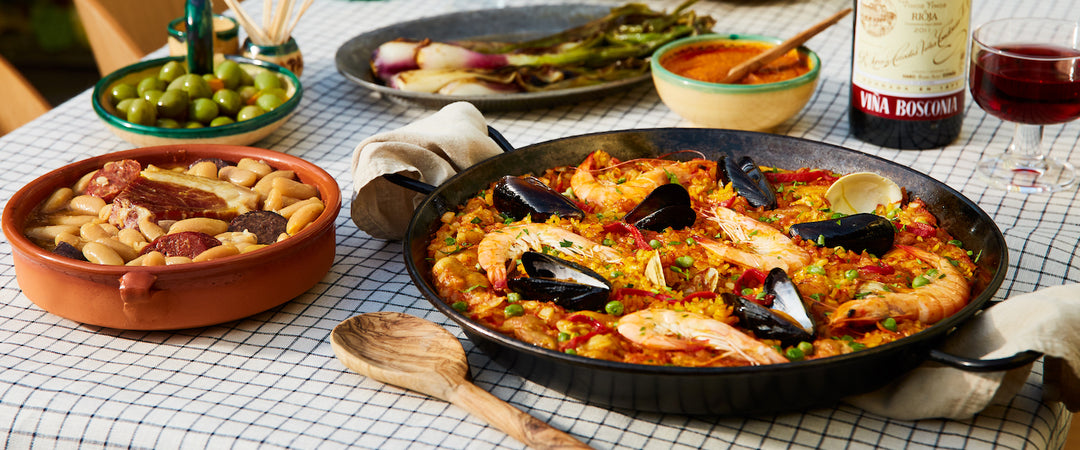February 2025 Tinto Club
 
|
Bodegas Ordonez 2022
|
It’s no secret that we are unabashed fans of Jorge Ordoñez’s selections. From Bodegas Muga to La Caña to Ramirez de la Piscina, you’ve seen this importers' wines on our walls time and time again. Whether you’ve consumed his wines continuously or not, if you’ve shopped our wine section for any decent amount of time, it's likely you’ve already taken part in Jorge Ordoñez’s voracious following. If we’re being honest, looking for his name on the reverse side of the bottle is a great way to do ‘backlabel shopping’, but more on that in another blog post. We’ll talk about the Garnacha we’ve selected in a moment, but first we’d like to express that we share a philosophical kinship to Jorge Ordoñez.

When the man himself arrived in the United States in 1987, he discovered a significant lack of quality Spanish wine available. This was due to a couple reasons. This first was that after Prohibition tore up much of the country’s Spanish and Italian grape vines, international French varieties were planted in their stead. This made domestic consumers more familiar with the varieties of Cabernet Sauvignon, Pinot Noir and Chardonnay rather than the Iberian and Italian grapes that were here long before. Look in any grocery store and you’ll see this trend continues to this day. The second reason for the poor presence and reputation of Spanish wine was due to inadequate shipping conditions. Spain is hot, and going from unconditioned warehouse, to truck-bed, to sitting in the sun on the Atlantic is a perilous and quality-infringing journey for a pallet of wine. Similar to our own mission statement, Jorge Ordoñez thus set out to bring true, unadulterated tastes of Spain to the American people. He began by advocating for proper handing of imported wine, demanding they be refrigerated at all steps of the journey. As Americans began to take notice, Ordoñez expanded into the production side of the wine trade, opening bodegas and working with winemakers in order to highlight indigenous varieties and terroirs all across Spain. To this day, his work serves as a cornerstone of the domestic Spanish wine market.

It was no surprise when we came across a Garnacha from his hometown, produced under a winery of his own namesake, we were instantly enamored. Deep in the south of Spain, high in the mountain ranges of Sierras de Málaga, Ordoñez grafted Garnacha from his holdings in Calatayud. The vines in Malaga planted with these cuttings have been maturing on their steep hillsides since 2010. The slopes here are steep, some angles teetering up to 60°. Everything here has to be hand farmed, no wheeled machinery is safe on these grades. The vineyards are dry farmed, organic, and each vine is goblet-trained or shaped into a cup to protect the grapes from the unwavering sun.

In respect for the character of the grapes, only very gentle winemaking techniques were used. After a quick maceration in open-open fermenters, the juice is then transferred to demi-muid to undergo full malolactic conversion for softness. The wine then takes a quick nap for 6 months in old French oak barrels before bottling. While the final ABV reads about 14.5%, this retains a surprising amount of elegance. Ethereal red and black berries intermingle with dusty earth and subtle pepperiness. Enjoy with grilled lamb or steaks, or feel free to experiment with richer Spanish seafood dishes, such as bacalao a la vizcaina or zarzuela de mariscos.
PS: as this writeup was (wonderfully) done by one of our wine staff, I am adding only a small footnote. I was privileged to visit the vineyards from where these wines hail in Malaga. It is THE most unusual setting. Steep, 45º mountainside vineyards in dry mountains high above the mediterranean. SO steep in fact that only locals and donkeys harvest here because outside helpers only trip, fall and hurt themselves on these slopes.


And, to leave you longing, here is a snapshot of the moment when I decided to bring us all 10 cases of this amazing wine:

 
|
Bodegas Ramirez de La Piscina 2019
|
Had you tasted me on this wine blindly before my Fall 2024 wine tasting trip to Spain , I would have easily mistaken this for a "big Ribera Del Duero". Rich, black cherry and leather, big tannins and a fruit forward structure that is usually associated with the warmer climes of the Ribera region had me fooled, thinking Vega Sicilia rather than thinking of Rioja, from where this wine actually hails. Luckily, rather than in a blind tasting, I got to "meet" this wine at the producers estate, the lovely winery and vineyards of the Ramirez de La Piscina family. After several epic stops in Spain's Rioja regions, we stopped at a winery that, from the outside, was not as glamorous as many of the wineries in Rioja are. A fairly plain building with an old painted logo on the side welcomed us, and after all the fanfare at the multimillion Euro buildings we had visited in the days before, this would have felt like a letdown had we not just returned from an expertly led tour of the Ramirez de La Piscina vineyards. These are situated in the Abalos section of Rioja's Alavesa subregion. The vineyards are gorgeous and healthy, with bush vines sporting large healthy clusters of ripe fruit (we were there in September).

The Ramirez de la Piscina family of San Vicente have been farming grapes in this historic village since the 13th century. Their family name is shared with the hermitage of Santa María de la Piscina, a 12th century Romanesque hermitage, a historic landmark site that is engraved with the Ramirez family crest, speaking to the family's long history in Rioja. Today, they produce small quantities of extremely classical Rioja wines from estate and long-term contracted vineyards in San Vicente and Abalos, two of the most important villages in the Sonsierra Riojana, a geographic "triangle" of quality between San Vicente, Abalos, and Labastida.

Estate owned and vineyards leased on long term contracts in the villages of San Vicente de la Sonsierra and Abalos, sandwiched between the foothills of the Sierra Cantabria mountain range and the Ebro River. Sustainable dry farmed viticulture. Vineyards trained as spur-pruned goblet vines as well as high density trellises. Manual work and harvest, with no mechanization whatsoever. The grapes undergo rigorous manual sorting before destemming. 100% of the clusters are destemmed, but not crushed. Temperature controlled fermentation in stainless steel (inoculated) with neutral yeast. Maceration lasts 20-30 days. The wine is racked to concrete tanks for malolactic fermentation, which occurs spontaneously. The wine is then aged 18 months French and American oak barrels in underground cellars. The cellars are a sight to behold, and showcase rows upon rows of the most unique barrels I have experienced: rather than age in american and french oak separatly, the Ramirez family ages in blended wood barrels, as can be seen in the RAF logo on the barrel. Roble American Frances.


As far as a food wine pairing goes, that is easy. Picture yourself being at the Ramirez family hosted dinner in their hunting room, add copious amounts of white asparagus with fresh olive oil, jamon iberico, cecina (dried beef loin), and freshly grilled garden vegetables made into pisto (a mix of peppers, zuchini, onion, eggplant), and other grilled vegetables from the garden. This appetizer course was followed by a hearty beef cutlets in a rich brown sauce, and follwed up with a flaky almond pastry for dessert. The wine matched all astoundingly well, with the obviously heartier parts of it matching the rich tannins of this Reserva best.




And, while food and wine are the highlights of this post, the visit at Ramirez ended up being my favorite, so I cannot help but share two additional footnotes.
Defending Future Wine
One of the most prevalent pests in the vineyards throughout La Rioja are wild boar. Absent natural predators (the wolf) these days, they are left to multiply and do great damage both by eating the actual grapes and by their bestial burrowing, rooting around and rubbing up against grape vines. A pair of boars can do substantial damage to a vineyard, so it not just for leisure that the Ramirez family hunts, but in literal agricultural self-defense. I am not much into hunting trophies, but in the context of a single boar damaging hundreds of vines, I could not help but harbor a wine enthusiasts "self-preservation" grin upon seeing their extensive trophy wall. Get your snout off my future Reserva, buddy! I do not think that boar wear stylyish hats in the wild, by the way.

Ancient Winemaking
One of the most astounding features in the vineyard was an ancient manmade feature in a large set of boulders bordering one of the vineyards. Carved into the top of this boulder was a shallow basin that was used in ancient times to make wine in the vineyard. Rather than haul the grapes to a cellar, in those times the grapes were stomped directly in these basins and only the juice carried back. The grape skins and stems were left in the vineyard. I can't picture the crudeness of such an operation, and I am glad this is NOT one of the ancient practices being revived. Nevertheless, it was fascinating to take such a deep look back in time.




